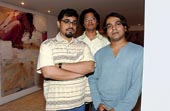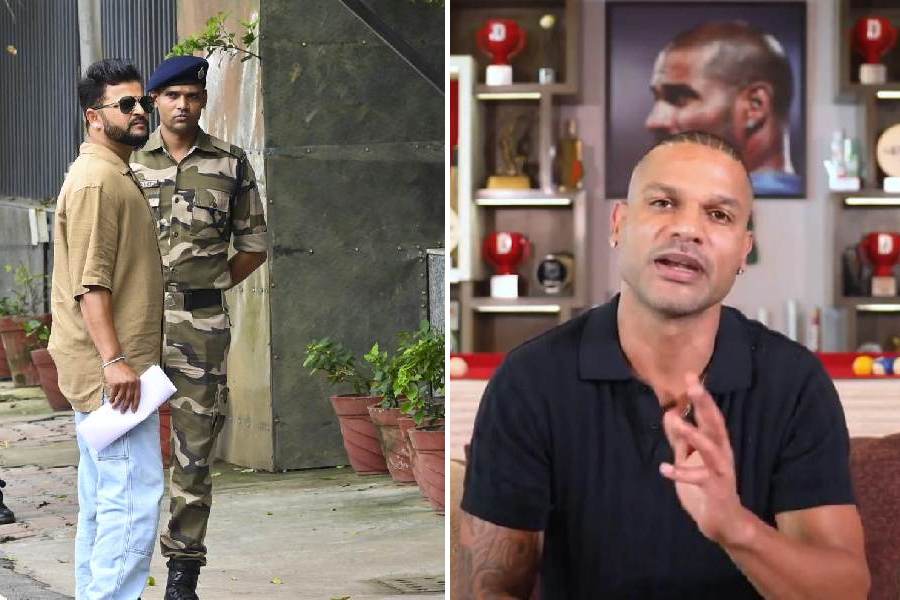 |
| (From left) Debraj Goswami, Uday Mondal and Abir Karmakar at CIMA Gallery. Picture by Aranya Sen |
Imagine Oscar Wilde in the Keller cartoon holding a sunflower but depicted in the nude. There is something repellent and obscene about a dainty man exposing his sagging flesh. This is how viewers in Calcutta may react to the “self-images” of Abir Karmakar. CIMA Gallery is exhibiting his works from Tuesday evening, along with those of two of his contemporaries from Baroda’s MS University — Uday Mondal and Debraj Goswami.
In real life Karmakar, like Goswami and Mondal, turns out to be a very ordinary young man from Siliguri, short and squat like any ordinary Bengali. One looks in vain for a hint of campishness. He is married to boot. Could he be the same man who had painted these sleazy images — almost pornographic in their content — of a man who could be posing for a skin flick? In this series titled, In the old-fashioned way, Karmakar’s academic training at Indian Art College confronts the Baroda credo. He tries to depict the “alternative ego”, “the feminine being within myself” through this and an earlier series where he created a “fictional autobiography”. His main concern was depicting flesh in all its materiality and corporeality, and he feels he has succeeded if one finds the paintings — almost as true to life as photographs — loathsome.
All these three artists just 30 or a tad more may look quite ordinary — their clothes are distinctly suburban — but as artists they are much sought after. They are booked by galleries all over the country and even abroad months in advance. And in the past one-and-a-half month’s time, the prices of their works have skyrocketed.
And this is what worries Goswami. He refuses to accept as a fact that bliss is it in this dawn to be alive and to be young like them very heaven. He tries to question such assumptions through his painstaking works.
He was trained as a printmaker and so each image is “decisive”. “There is nothing painterly about my works,” says Goswami, who is from Serampore. He appropriates slivers from paintings such as Guernica and Rodin’s Thinker and gives them a twist all his own. The “foetus” of a revolver is preserved in formaldehyde. The Thinker is “uprooted”. Gandhi is trapped in a safety pin. He is a skilled painter but it is difficult to accept rubber slippers as representative of the proletariat.
As a painter, Mondal could not have been more expressive. In his childhood his mother would ask him to paint with a brush made from a shred of cloth wound around a twig. Even now, he rarely uses a brush, preferring instead a roller and scrapper or even a napkin wound around a stick.
From Baroda’s photo-realism, Mondal has progressed to huge canvases on which he slathers huge quantities of paint — some works have 20 layers.
For an instant, his paintings look like photographs and then, the illusion is shattered as one realises that the large swathes of white, orange and yellow could not have been there in real life. The faces are smudged, although the reflection on the glass top is real. This play between illusion and reality is quite arresting and intriguing.










